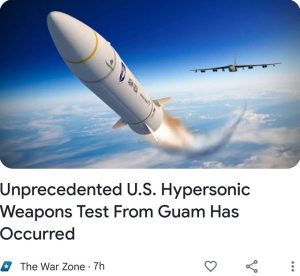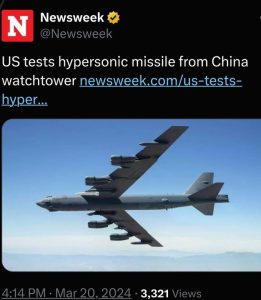US successfully Launches Hypersonic Missile In China’s ‘red Zone”



The US Air Force has finally confirmed that it conducted a live-fire test of the AGM-183 Air-launched Rapid Response Weapon (ARRW) on March 17, days after a B-52H bomber equipped with the hypersonic weapon made an appearance at Guam’s Andersen Air Force Base.
According to a US Air Force official, on March 17, local time, “a B-52H Stratofortress conducted a test of the All-Up-Round AGM-183A Air-launched Rapid Response Weapon” at the Reagan Test Site close to Kwajalein Atoll. The bomber took off from Andersen AFB.
“This test launched a full prototype operational hypersonic missile and focused on the ARRW’s end-to-end performance,” the spokesperson said. The Air Force “gained valuable insights into the capabilities of this new, cutting-edge technology” from the event.
When the images of the weapon in Guam first started infiltrating the internet, there was speculation that a test was imminent.
Although the service has remained tight-lipped about its objectives, the test may have been conducted to validate the performance of the ARRW, characterize the behavior of an incoming, maneuvering hypersonic missile, and gather information for creating hypersonic missile defenses.
The Air Force did not specify the precise test goals or divulge information about the flight duration, the location of the surface impact, or whether the launch, separation, and glide sequence proceeded as planned.
The spokesperson claimed, “This test acquired valuable, unique data and was intended to further a range of hypersonic programs,” most likely alluding to the HACM or Hypersonic Attack Cruise Missile. “We also validated and improved our test and evaluation capabilities for continued development of advanced hypersonic systems.”
Without giving too much away, the service used the same wording for the previous three end-to-end tests of live ARRW missiles, which took place in March, August, and October of 2023. While the service acknowledged that the March test failed, the results of the other two have been cloaked in secrecy.
The AGM-183A ARRW is a long-range hypersonic missile designed by Lockheed Martin for the USAF. The missile was expected to improve USAF’s hypersonic strike capability to attack heavily defended, high-value targets such as enemy military bases and surface warships at stand-off ranges. The death knell on the program was sounded just days after the failed test.
The latest test has sparked a lot of interest as it came after the US Air Force announced its intention to disband the troubled ARRW hypersonic weapon program last year. For this reason, several internet users joked that the hypersonic missile had returned from the dead to be tested in the region nearest to China
The latest ARRW test comes even though the US Air Force is not keen on the program, as evidenced by its budget request for fiscal 2025. While the USAF has requested $517 million to continue developing the HACM, the service’s FY25 budget does not allocate any money for Lockheed Martin’s ARRW for research and development or purchases.
Previous reports noted that the service will complete its rapid prototyping program this year and has one last all-out round test scheduled for the weapon shortly. “With ARRW … we are undergoing the final test of the all-up-round [AUR] with a planned test program completion by the end of [the] second quarter [of] Fiscal Year 2024,” said Air Force Lt. Gen. Dale White, the Military Deputy at the Office of the Assistant Secretary of the Air Force for Acquisition, Technology, and Logistics. “Future ARRW decisions are pending final analysis of all flight test data.”
However, despite these details, the recent test is still significant as it was the first test launch of an American hypersonic weapon in this region. Thus, the test appears to be a signal sent across the Pacific, particularly to China.
China Must Be Watching!
The report of the ARRW test is expected to create a frenzy in China for two reasons: one, the US has been working relentlessly to close the glaring gap in hypersonic capability with China, and two, the strategic significance of Guam by its location in the Pacific.
Guam is an American territory in the Pacific that is expected to be used as a launch pad for US Air Force bombers and fighter jets conducting missions against China in the event of hostilities. This is why Anderson AFB is being rapidly militarized and its defenses augmented.
Earlier this year, Anderson AFB saw the deployment of B-52 Stratofortress bombers, which the military describes as being “designed to showcase the US’s ability to deter, deny, and dominate. BTF (Bomber Task Force) missions aim to influence and dissuade aggression from adversaries or competitors.” In June and October of 2022, B-1 bombers were also sent to Guam as part of Bomber Task Force missions.
The US Air Force is actively investigating novel ideas for dispersed operations and expeditionary flying, and Guam is important to its strategy for a possible Pacific war with China. Given that a hypersonic weapon is more difficult to intercept due to its high speed and unpredictable trajectory, including one in this strategy should help those efforts.
Guam’s location in the Pacific means that China is undoubtedly keeping a close eye on the island. China should become uneasy if a hypersonic weapon from Guam is tested in real-time.
Experts also think that China’s growing anti-access/area denial (A2/AD) capabilities make the development and testing of a next-generation air-launched standoff weapon essential.
China’s A2/AD capabilities in the Pacific threaten US and ally military facilities and supply routes, prevent theater access, and reinforce critical assets in the event of a Taiwan or South China Sea crisis.
China’s concerns are reflected in its criticism of the rapid militarisation of Guam. In August last year, Beijing warned Washington against turning Guam into a US “outpost to wage wars.”
Senior Col. Wu Qian, spokesman for China’s Defense Ministry, said, “As for Guam … its security depends on what role the US wants Guam to play. If Guam were to be an outpost to wage wars, it would not be secure even if it were armed to the teeth.”
The reason behind the ARRW’s resurrection for testing remains unclear due to the USAF’s lack of specific information, but the missile’s appearance raises the possibility that the reports of its demise were greatly exaggerated. However, no matter what the future holds for the ARRW, China is watching.




